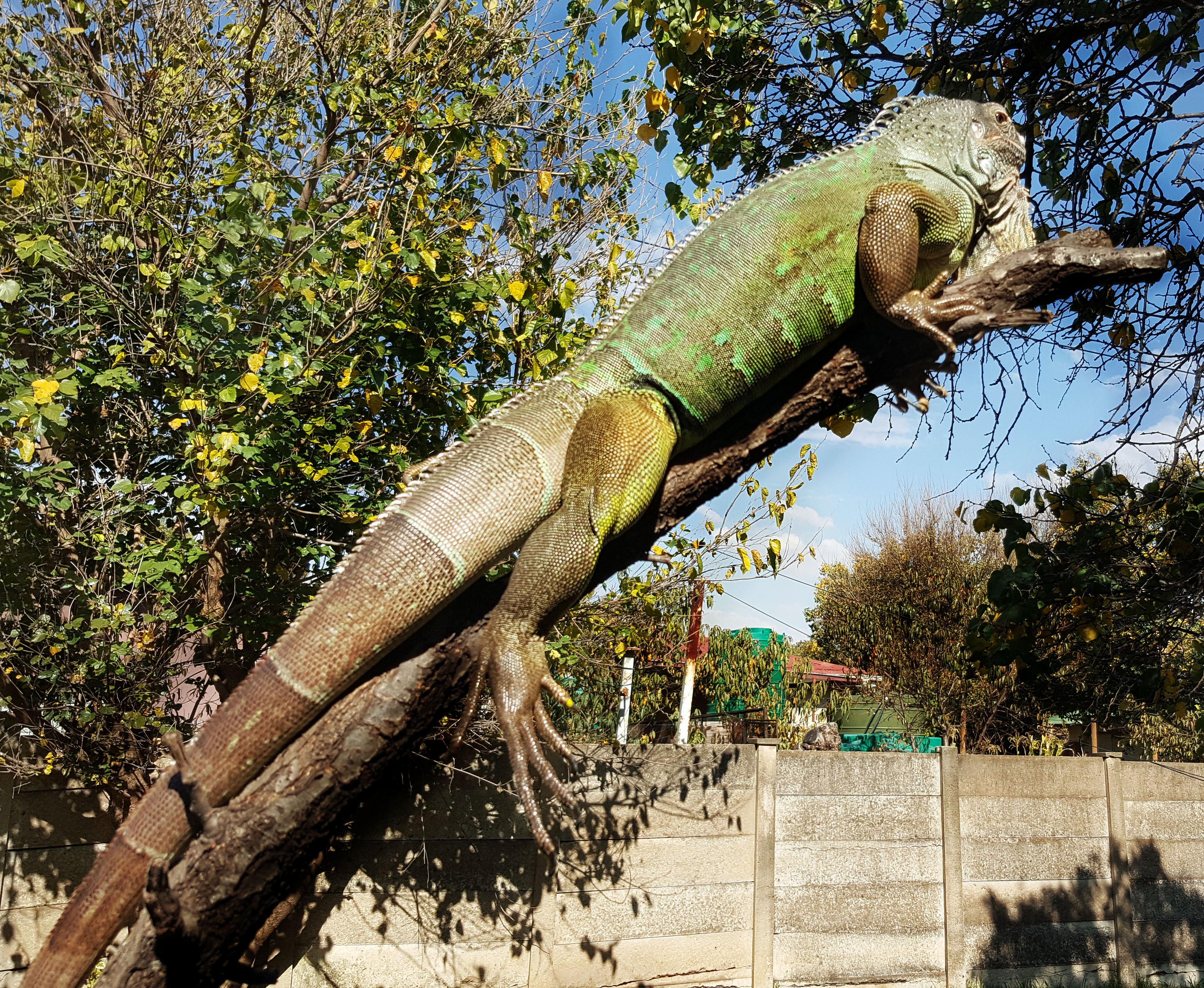Replicating ecological conditions for iguanas in captivity is a very challenging task. Iguanas are very dependent on their surroundings in terms of temperature body heat and food supply for the proper body chemistry and metabolism.
Iguanas inhabit the forests of Central and South America and the Caribbean Islands. They inhabit trees growing near bodies of water in the deep jungle. They prefer adjacent to water sources as a form of defense from predators. There, they can be seen basking on large horizontal tree limbs or feeding amongst the foliage. Iguanas are intensely territorial so no more than a single large male will be found in a specific area encompassing about a quarter to a half-acre in size. In captivity, cage size is often not much longer than 1.5 times the iguana’s length.
The natural habitat for iguanas is warm and humid. It is very important that their artificial homes be as near to the real-life condition of their habitat as possible, in terms of heat and humidity. Failure to do so could lead to Illness or death.
Planning a Comfortable Habitat for Your Iguana
Even before you consider purchasing an iguana, you must consider its needs for a proper home. Since the iguana’s health is dependent on the actual environment that he lives in, it is essential that this part of the process happen first, before anything else.
Iguanas use their homes for more than just shelter. It is imperative that his/her home provides the necessary protection but also the right heat for its well-being. Unlike dogs or other mammals, iguanas must have a well-maintained climate in order to stay healthy.
This is due to the iguana’s need for the wavelengths of light within its home. They will use these wavelengths to aid in their metabolism as well as in their body chemistry.
If you consider where the iguana is from, you can see what his needs will be in the climate that you create for him. The extreme temperatures of that environment were also fairly humid. This combination is what his body is conditioned for and therefore must be replaced in the shelter you’ll provide for him if he is to survive and be as healthy as he can be.
Without an environment that is conditioned for the right temperature and humidity, your iguana will become ill, it will suffer and it may even die because of this one simple factor.
One thing that can’t be stressed enough is the need to educate yourself before purchasing the habitat for your iguana. Since this is such an important decision, you don’t want to make costly mistakes.

What does he/she need, then? There are several key pieces of information to consider. We’ll break them down for you right here.
Size
Do you need lots of room? The iguana is so small, how can they even imagine needing so much room? No matter what you thought about his size or the room he needed, this is an important consideration.
First, they aren’t small. In many cases, an iguana will grow up to six feet in length. That’s a lot of iguana for you to provide shelter for. There is one misconception out there about this, though. Many think that if they limit the room that they provide to their iguana they will be safely protecting it from getting extremely large. This is not true. He will continue to grow. Iguanas start growing at a faster rate than they will down the road. But, he will grow his entire life. Within your first year of owning him, your iguana will likely grow out of the 55-gallon aquarium that you bought it. For this consideration alone you should carefully decide on whether this is the right pet for you. Space is necessary for the animal.
Regular iguana cages must be around 6 feet tall with a width twice as long. This size gives room also for branches of trees where the iguanas could stay and play around. As a rule, the width of the cage must always be twice the height. If the cage size is small, It will also promote the build-up of fat and eventually make them stagnant, weak, and prone to sickness.
Heating and Lighting For Your Iguana
Within your habitat, you’ll need to provide a location that can provide basking heat. Generally, this area should be able to get to the middle 90s in temperature. (All temperatures in this article are listed in Fahrenheit.) The rest of the air within the habitat should be maintained at no less than 75 degrees, but better if it is closer to 80. The final need is to offer a range of temperatures within the habitat to allow him to move around as he feels comfortable.
The room temperature that must be observed must be 80 to 95 degrees Fahrenheit. The basking temperature they need from the sun ranges from 90 to 95 degrees Fahrenheit while the regular air temperature they are accustomed to is no lower than 80 degrees Fahrenheit. Being cold-blooded reptiles, they need that much heat. It is part of their normal body metabolism, especially their digestive system. Without the proper surrounding temperature, iguanas will not be able to digest their food properly and trigger illness which may compound into more health issues eventually. Iguanas like other animals do sleep, therefore it is necessary that their surroundings be able to provide total darkness during the night without jeopardizing the required temperature.
Like most things that grow, iguanas need sunlight too. Not only to have the light but to also absorb it. An iguana will utilize UVA and UVB light so it can absorb nutrients correctly. The UVB light will trigger a chemical reaction in the reptile’s skin which will help make vitamin D3. What does D3 do? It processes the calcium within the bloodstream.
Now, to accomplish this, there are several things you should and shouldn’t do.
First, purchase several attachment thermometers. Place these in various areas of the habitat so that they can be easily read by you from outside the enclosure.
A proper UVB light should be placed where it will reach the entire cage. I do recommend going with the Reptizoo linear tube as this offers the best coverage.
Provide a basking area by placing a heat lamp in one specific area of the cage.
A heat mat will also help to get temps up. (Be wary of where you place it!)
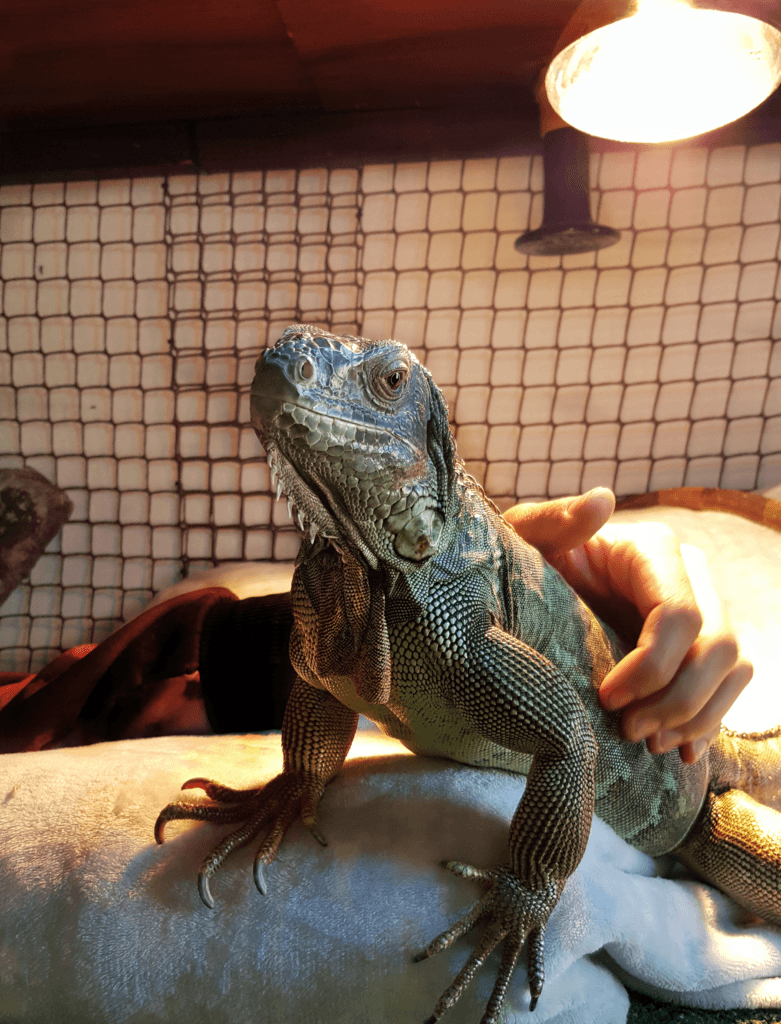
Maintaining The Habitats’ Humidity
Now that you have your habitat built and set up with the right amounts of heat and light, the next part is humidity.
Humidity is the amount of moisture that is in the air. Since iguanas come from areas that are generally very high in humidity all the time, you’ll need to mimic that here in your habitat. But, how in the world do you create the right amount of humidity?
The right level of humidity for your iguana will be between 65 percent and 75 percent, which are fairly humid conditions. There are several ways for you to get this high of a humidity level within your habitat.
First, there are simple methods to doing this. You can just spray the habitat down with water throughout the day. Don’t spray less than an hour before the lights go out for the night though. You can also place large containers of water in the habitat, which will help to make for the right amount of humidity within the habitat, too. If you live in a dry place, I do recommend using a humidifier as this will keep the humidity constant and be less of a struggle to keep up.
A bath and some misting are also recommended to keep the skin moist and aid with shedding.
Flooring Covering/ Substrate
The surface of the iguana’s habitat is composed of substrates. You need to remember that iguanas will continuously flick their tongues. Why do iguanas do this if they can see? By flicking their tongue, it gives the iguana information about their immediate environment. As such, do not use wood chips, sand, or gravel since wood chips can cause a choking hazard and the sand or gravel are overly dangerous if they are ingested by your iguana.
Now, when it comes to your habitat’s flooring, take this into consideration closely. You want to have something that is easy to replace or at least to clean. But, you don’t want to have anything that your iguana can pick up with his tongue or even worse get wrapped around his toes.
You’ll find many materials available in pet stores but don’t waste your time on them. Instead, consider other easier-to-afford materials. Here are some options you have.
Floors of:
· Newspaper, ensure that it does not have any type of toxic ink on it.
· Paper towels work just fine, too.
· Plain papers without any type of toxins in them.
· Outdoor carpeting.
The carpeting is a great choice but if you purchase it, make sure it has nothing that can get caught on your iguana’s toes. You’ll want to wrap it around the edges and tape them underneath to keep them from being torn up or getting caught on his tongue.
Food and Water Dishes
Like any other animals, iguanas need to have food and water. Even though iguanas don’t need to drink often, it is still vital for them to have fresh water on a daily basis. Get a water dish that is the right size for your pet because they love to lay in it. It should be one that won’t easily tip over and it should be shallow for them not to drown in.
Iguanas are very meticulous about the water. After they are done soaking in it, iguanas will tend to poop in the water. This means as an iguana owner, you need to change the water often so it will need to be sanitized on a daily basis to avoid germs that can make your iguana sick.
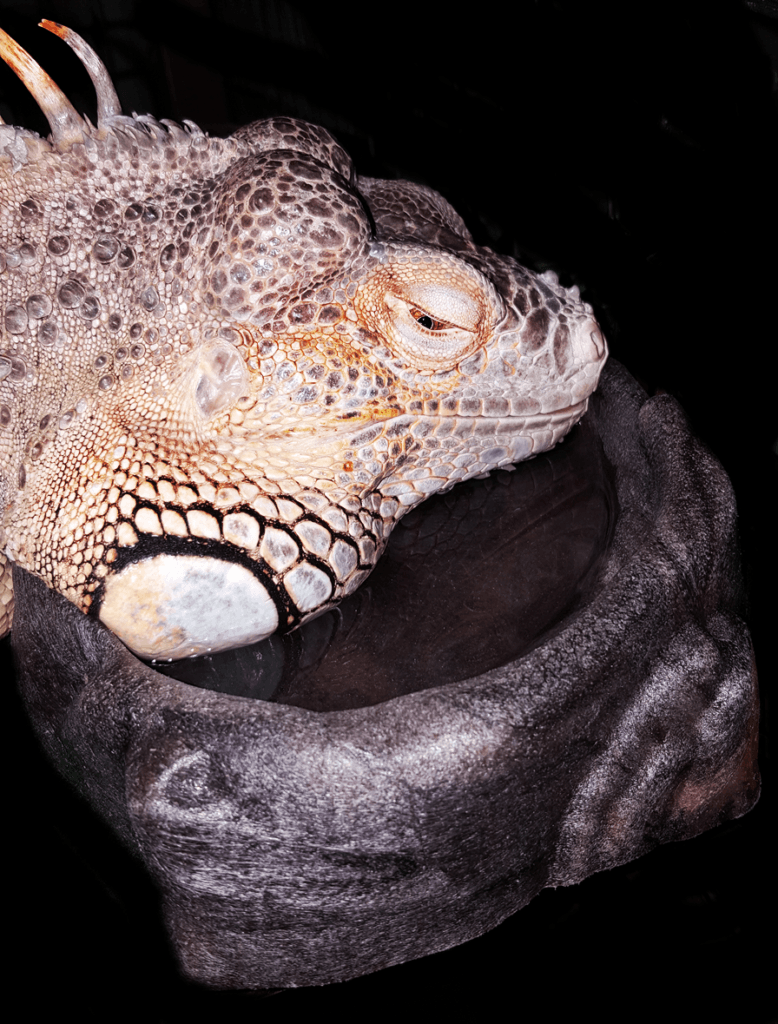
Hiding Places
Just as with people, sometimes, an iguana just wants to be left alone. Logs, wood boxes, and so forth, can be used to create a hide, or hiding place for the iguana to step into when some alone time is needed.
Basking and Climbing Accessories
Iguanas spend more of their time in trees so placing some kind of climbing material in your iguana’s environment could make them feel more at home as if they were in the wild. This leads to them leaning on you more for their needs. Shelves from an old bookshelf or shelf that is not going to be used from a computer desk can be an acceptable substitution for tree branches. Regular branches may not always hold your iguana.
Understand if you do include branches in the habitat; provide enough of them and some that are big enough for the iguana to lay on during their resting times. One of the ways you can do this is to place carpeting on the branches. These will also serve as a basking place for your iguana.
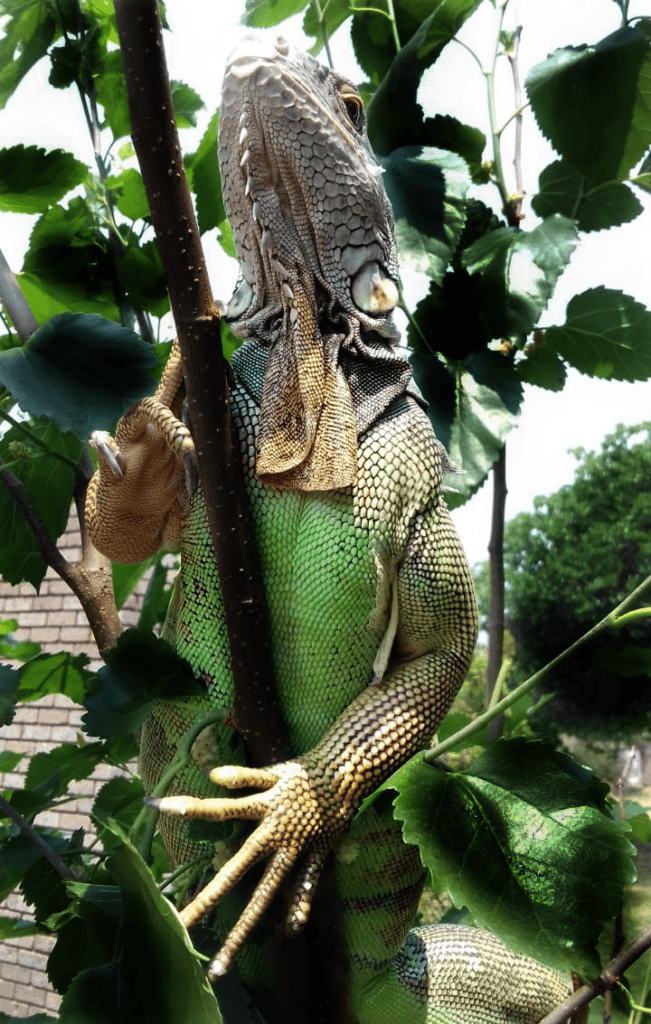
Circulation
The air circulation is an important factor that has to be considered. Make sure the cage has abundant ventilation from all sides but has cover for protection. For regulation of air, a low-cost, quiet, and small fan can be used. Mildew can be prevented if there is proper regulation in the cage.
Buying Or Building?
You can build your habitat. There is no doubt that this is a great way to go. Or, you can buy a pre-made habitat for your pet. Take that one step further and you can have someone else make a habitat for you and then buy it from them. In any case, what you have to determine is the correct way to build or buy one. The largest drawback of purchasing your own, pre-made habitat is cost. They are by far expensive homes to purchase for your pet. Sometimes, they are well-designed to provide for most of the iguana’s needs. But, most of the time, they aren’t. In fact, most of what you will find in your local pet store is far too small for your iguana. Sure, it’s a great habitat until they grow to their full adult size!
There are a number of great locations online that can help you to design your own custom-made iguana habitat. Purchasing one is not a bad idea, but it will have to be done with a full understanding of what you need that habitat to provide for your pet. Don’t underestimate the size of your iguana!
The Iguana Habitat – Additional Information to Keep In Mind
- A heating pad can be used in the nighttime to warm up the atmosphere. A bulb consuming less electricity can be used. A 75-watt light would do the job. Heat emitters work great too, and it doesn’t disturb their rest.
- The electrical connections have to be carefully placed. They are very intrusive creatures, you will find them trying to climb and jump hot light equipment and accessible wirings.
- Make sure the cage is far away from pests. The leftover foods should be removed as early as possible.
- An iguana that is confined in a small space will become stressed and restless. This often leads to sickness and may make the iguana vulnerable to diseases. This fact may not seem obvious as the iguana may seem at ease with a small enclosure, though this should not mislead you.
- The iguana’s psychological growth as well as its emotional one depends on two activities that it undertakes, these being basking and climbing. The large branches allow it to carry out these two activities.
- Iguanas have great eyesight and can see far distances, shapes, colors, and movements. It may be a good environment for it to be covered with nature or colors and shapes emulating nature. Wall paintings with caricatures of birds and trees will be a treat. However, it would be best if the cage could be placed within a covered garden with a controlled environment.
- Iguana’s ears are called tympanum which are located behind the eyes. Like their eyes, their auditory system is so sensitive. Loud noises and other irritating sounds must be avoided. Provide them with quiet and peaceful surroundings.
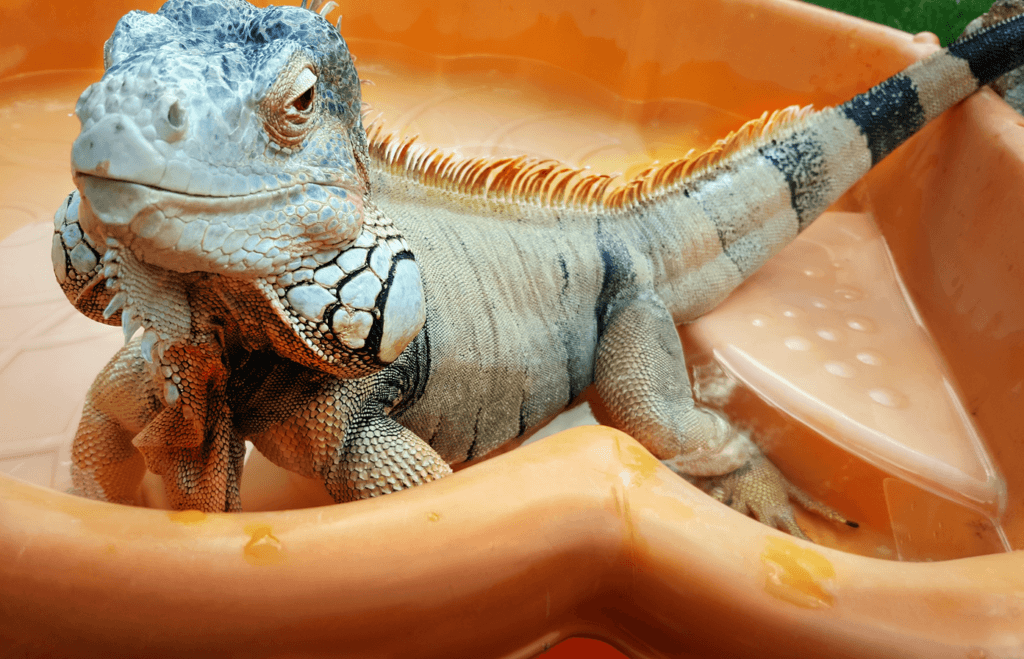
Iguana’s New Habitat – Time to Adjust
Give your Iguana time to adapt to the new home. They might hurt themselves or be traumatized in a new home. Their reaction would be by scratching and rubbing the walls. It will be better if you spend the first few days with your Iguana. Try to create a bond with the pet till it gets used to the new environment.
The best thing to do to make an iguana feel at ease in their new surroundings is not to move it from its small place first. This means letting the iguana find a small space, away from everyone.
Watch the iguana for a few weeks, and you should then chart down any changes the animal will project.
Like most animals and even people, moving an iguana can be stressful for them. Do not worry if you cannot handle your iguana in the beginning. The taming process happens in the first few weeks of its life and it makes the iguana grow faster.
Finding a good veterinarian is essential for the animal’s health and well-being. Be sure to wait until he has acclimated into his new surroundings then start taking him for a regular checkup.
